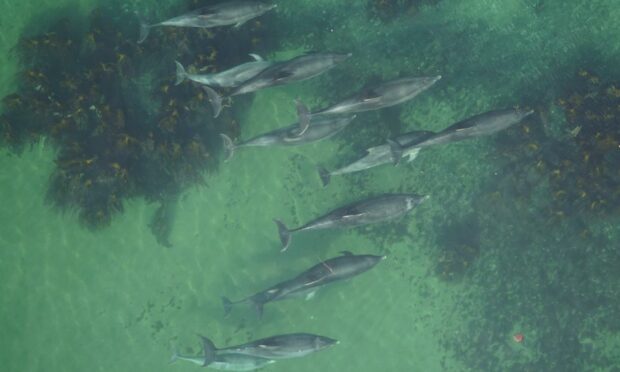Researchers from Aberdeen University are the first to use drones to non-invasively identify pregnant dolphins.
Drones take aerial photos of dolphin pods, then scientists measure the body width of the females in the group to identify which ones are pregnant.
For the first time, they will be able to monitor failed pregnancies as well as successful ones.
This information will help in the long-term, as a failed pregnancy could provide information on a dolphin’s health.
It is also hoped that it will help identify the causes behind an unsuccessful pregnancy, for example due to lack of food.
The new method has been trialed on the bottlenose dolphin population in the Moray Firth, which teams from the university have been studying for over 30 years.
‘First time it has been done for small cetaceans’
Previously, researchers studying the Moray Firth dolphins were only able to keep track of pregnancies that resulted in a calf.
Now, they will also be able to monitor unsuccessful ones and determine the reason why this was the case.
Research fellow in the school of biological sciences, Barbara Cheney, said: “The main aim of the study was to explore whether we could remotely determine pregnancy status from aerial photographs taken using an unoccupied aerial system or drone.
“Similar studies have been carried out for larger whales but as far as we know this is the first time it has been done for small cetaceans.
“This is important because reproductive success is key to a population’s growth, but it is particularly challenging to measure in wild populations. By using aerial photos this will allow us to routinely monitor changes in reproductive success in this protected bottlenose dolphin population supporting conservation.”
‘Provide us with a wealth of new data’
Ms Cheney and the team have been working at Lighthouse Field Station, in Cromarty, in collaboration with Duke University in the USA and their Marine Robotics and Remote Sensing Laboratory (MaRRS).
They carried out five boat-based surveys in July and August 2017 and a total of 64 dolphins were identified.
Just one of the 15 dolphins whose pregnancy status was known, was incorrectly identified as being not pregnant.
Ms Cheney explained how this study could help determine the cause of failed pregnancy in a bottlenose dolphin: “Data on failed pregnancies could provide information on how healthy a particularly dolphin is as well as helping to identify the causes of changes in the population.
“We know that reproductive failure has been linked to harsh environmental conditions, pollution and naturally occurring toxins but previously we have only been able to estimate the impact in populations where animals are easy to capture or remotely sample.
“Gathering information is also particularly challenging in cetaceans that are highly mobile and spend much of their time underwater. This study will provide us with a wealth of new data to further improve our knowledge and understanding of reproductive success in bottlenose dolphins.”
